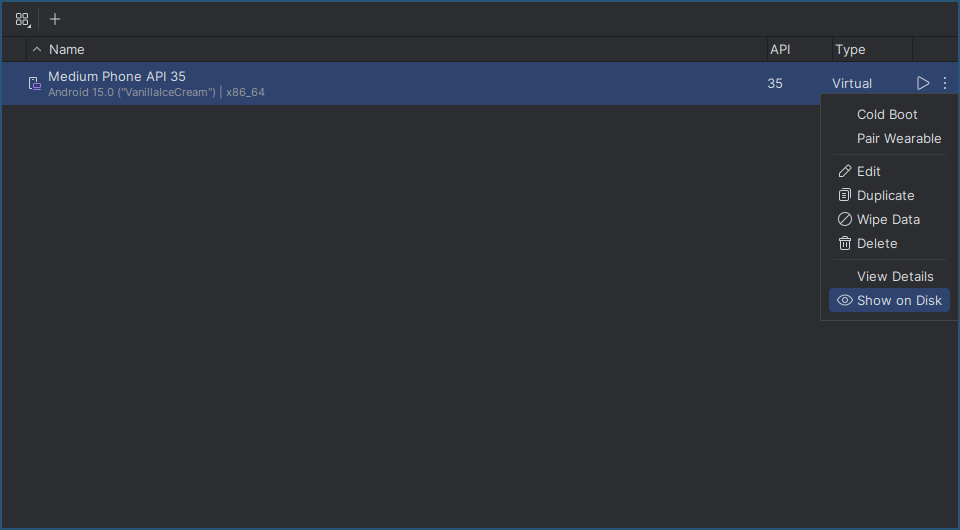Note on extracting OBB files in Android
This is just a collection of notes on how to extract opaque binary blobs (OBB) from Android apps using the emulator. Useful when you have apps that download somewhat static content that one would like to extract, e.g. dictionary apps such as SAOL.
In rough terms:
- set up an emulator
- install the app
- decrypt and mount the image
- access the file(s)
Setting up an emulator
The easiest, but heaviest in terms of storage, is to install Android Studio.
As usual, on NixOS (or using nix elsewhere) this is just
$ NIXPKGS_ALLOW_UNFREE=1 nix run --impure nixpkgs#android-studioThis should come with an Android Virtual Device (AVD) already set up and ready to use.
(Note: running the emulator on Wayland required QT_QPA_PLATFORM=xcb
as documented on the excellent archlinux
Wiki)
Installing the app
Well, you’re on your own here. One option is to sign in to Play Store
and downloading it. Another is to download an (X)APK from third-party
sites and installing it through adb. Pick whatever works.
Some apps download data on launch, so make sure you run the app and let it fetch whatever you need.
Terminate the emulator afterwards.
Decrypting the AVD image
First, locate where the AVD is stored. This can be done in the Device Manager in Android Studio with the “Show on Disk” option.

It should be in ~/.android/avd/.
$ ls ~/.android/avd
Medium_Phone_API_35.avd Medium_Phone_API_35.iniThe AVD contains the encrypted userdata-qemu.img.qcow2 file for
which we’ll use
SlugFiller/fbe-decrypt to
decrypt.
The instructions in the README are pretty clear. In short, this is enough (again using Nix):
$ (cd /tmp && git clone git@github.com:SlugFiller/fbe-decrypt.git)
$ # From the AVD directory, e.g. ~/.android/avd/Medium_Phone_API_35.avd
$ nix run nixpkgs#nodejs -- /tmp/fbe-decrypt/fbe-decrypt.mjs
Decrypting 393216 of 393216 inodes
Changed 1027833 blocks and 37542 buffers
Written 1572864n of 1572864n blocksThe extracted image is userdata-decrypted.img.
Mounting and extracting
Now, mount it somewhere reasonable, like /mnt/device or /run/mount/device.
$ sudo losetup --find --show userdata-decrypted.img
/dev/loop0
$ sudo mkdir /run/mount/device
$ sudo mount -t ext4 /dev/loop0 /run/mount/device
$ ls /run/mount/device
adb app-staging gsi_persistent_data nfc rollback-observer user
anr backup incremental ota server_configurable_flags user_de
apex bootchart local ota_package ss vendor
app cache lost+found per_boot storage_area vendor_ce
app-asec dalvik-cache media preloads system vendor_de
app-ephemeral data mediadrm property system_ce
app-lib drm misc resource-cache system_de
app-metadata fonts misc_ce rollback tombstones
app-private gsi misc_de rollback-history unencryptedPerfect! All good! Let’s find all .obb files.
$ sudo find /run/mount/device -name '*.obb' 2>/dev/null
/run/mount/device/data/se.svenskaakademien.saol/files/assetpacks/database/64/64/assets/main.28.se.svenskaakademien.saol.obbNote: sudo because permissions are very restricted, 2>/dev/null to
remove a bunch of Structure needs cleaning errors.
When done, unmount as usual:
$ sudo umount /run/mount/device
$ sudo losetup -d /dev/loop0It might also be useful to delete the image, since it’s quite large.
$ ls -lh userdata-decrypted.img
-rw-r--r-- 1 rasmus users 6.0G 15 jan 11.24 userdata-decrypted.img